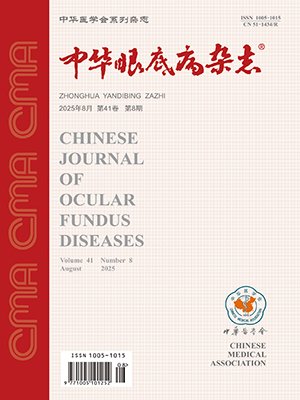| 1. |
Ikuno Y, Jo Y, Hamasaki T, et al. Ocular risk factors for choroidal neovascularization in pathologic myopia[J]. Invest Ophthalmol Vis Sci, 2010, 51(7):3721-3725.
|
| 2. |
Wood A, Binns A, Margrain T, et al. Retinal and choroidal thickness in early age-related macular degeneration[J].Am J Ophthalmol, 2011, 152(6):1030-1038.
|
| 3. |
Chung SE, Kang SW, Lee JH, et al. Choroidal thickness in polypoidal choroidal vasculopathy and exudative age-related macular degeneration[J]. Ophthalmology, 2011, 118(5):840-845.
|
| 4. |
Mitchell P, Korobelnik JF, Lanzetta P, et al. Ranibizumab (Lucentis) in neovascular age-related macular degeneration:evidence from clinical trials[J]. Br J Ophthalmol, 2010, 94(1):2-13.
|
| 5. |
Monés JM, Amselem L, Serrano A, et al. Intravitreal ranibizumab for choroidal neovascularization secondary to pathologic myopia:12-month results[J]. Eye, 2009, 23(6):1275-1280.
|
| 6. |
Silva RM, Ruiz-Moreno JM, Rosa P, et al. Intravitreal ranibizumab for myopic choroidal neovascularization:12-month results[J]. Retina, 2010, 30(3):407-412.
|
| 7. |
Vadalà M, Pece A, Cipolla S, et al.Is ranibizumab effective in stopping the loss of vision for choroidal neovascularisation in pathologic myopia? A long-term follow-up study[J].Br J Ophthalmol, 2011, 95(5):657-661.
|
| 8. |
Ellabban AA, Tsujikawa A, Ogino K, et al. Choroidal thickness after intravitreal ranibizumab injections for choroidal neovascularization[J]. Clin Ophthalmol, 2012(6):837-844.
|
| 9. |
Lim LS, Mitchell P, Seddon JM, et al. Age-related macular degeneration[J]. Lancet, 2012, 379(9827):1728-1738.
|
| 10. |
Kaiser PK, Boyer DS, Cruess AF, et al. Verteporfin plus ranibizumab for choroidal neovascularization in age-related macular degeneration:twelve-month results of the DENALI study[J]. Ophthalmology, 2012, 119(5):1001-1010.
|
| 11. |
CATT Research Group, Martin DF, Maguire MG, et al. Ranibizumab and bevacizumab for treatment of neovascular age-related macular degeneration:two-year results[J]. Ophthalmology, 2012, 119(7):1388-1398.
|
| 12. |
Gaudreault J, Fei D, Beyer JC, et al. Pharmacokinetics and retinal distribution of ranibizumab, a humanized antibody fragment directed against VEGF-A, following intravitreal administration in rabbits[J]. Retina, 2007, 27(9):1260-1266.
|
| 13. |
Heiduschka P, Fietz H, Hofmeister S, et al. Penetration of bevacizumab through the retina after intravitreal injection in the monkey[J].Invest Ophthalmol Vis Sci, 2007, 48(6):2814-2823.
|
| 14. |
Peters S, Heiduschka P, Julien S, et al. Ultrastructural findings in the primate eye after intravitreal injection of bevacizumab[J]. Am J Ophthalmol, 2007, 143(6):995-1002.
|
| 15. |
Shimomura Y, Hirata A, Ishikawa S, et al. Changes in choriocapillaris fenestration of rat eyes after intravitreal bevacizumab injection[J]. Graefe's Arch Clin Exp Ophthalmol, 2009, 247(8):1089-1094.
|
| 16. |
Kang HM, Kwon HJ, Yi JH, et al. Subfoveal choroidal thickness as a potential predictor of visual outcome and treatment response after intravitreal ranibizumab injection for typical exudative age-related macular degeneration[J]. Am J Ophthalmol, 2014, 157(5):1013-1021.
|
| 17. |
Spaide RF, Koizumi H, Pozzoni MC. Enhanced depth imaging spectral-domain optical coherence tomography[J].Am J Ophthalmol, 2008, 146(4):496-500.
|
| 18. |
Lim SJ, Roh MI, Kwon OW. Intravitreal bevacizumab injection for central serous chorioretinopathy[J]. Retina, 2010, 30(1):100-106.
|
| 19. |
Yamazaki T, Koizumi H, Yamagishi T, et al. Subfoveal choroidal thickness after ranibizumab therapy for neovascular age-related macular degeneration:12-month results[J]. Ophthalmology, 2012, 119(8):1621-1627.
|
| 20. |
Margolis R, Spaide RF. A pilot study of enhanced depth imaging optical coherence tomography of the choroid in normal eyes[J]. Am J Ophthalmol, 2009, 147(5):811-815.
|
| 21. |
McDonnell EC, Heussen FM, Ruiz-Garcia H, et al. Effect of anti-VEGF treatment on choroidal thickness over time in patients with neovascular age-related macular degeneration[J]. Eur J Ophthalmol, 2014, 24(6):897-903.
|
| 22. |
Shao L, Xu L, Chen CX, et al. Reproducibility of subfoveal choroidal thickness measurements with enhanced depth imaging by spectral-domain optical coherence tomography[J]. Invest Ophthalmol Vis Sci, 2013, 54(1):230-233.
|




